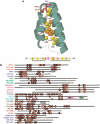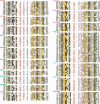HEAT repeats associated with condensins, cohesins, and other complexes involved in chromosome-related functions
- PMID: 11042144
- PMCID: PMC310966
- DOI: 10.1101/gr.147400
HEAT repeats associated with condensins, cohesins, and other complexes involved in chromosome-related functions
Abstract
HEAT repeats correspond to tandemly arranged curlicue-like structures that appear to serve as flexible scaffolding on which other components can assemble. Using sensitive sequence analysis techniques we detected HEAT repeats in various chromosome-associated proteins, including four families of proteins associated with condensins and cohesins, which are nuclear complexes that contain structural maintenance of chromosome (SMC) proteins. Among the proteins detected were the XCAP-D2 and XCAP-G subunits of the Xenopus laevis 13S condensin complex, the Aspergillus BimD and Sordaria macrospora Spo76p proteins, the budding yeast Scc2p protein, and the related Drosophila transcriptional activator Nipped-B. Clathrin adaptor and COP-I coatomer subunits, which function in vesicle coat assembly and were previously noted to share weak sequence similarity to condensin subunits, also contain HEAT repeats. HEAT repeats were also found in the TBP-associated TIP120 protein, a global enhancer of transcription, and in the budding yeast Mot1p protein, which is a member of the SWI2/SNF2 family. SWI2/SNF2 proteins, some of which are helicases, perform diverse roles in transcription control, DNA repair, and chromosome segregation and form chromatin-remodeling complexes. HEAT repeats also were found in dis1-TOG family and cofactor D family microtubule-associated proteins, which, owing to their roles in microtubule dynamics, perform functions related to mitotic progression and chromosome segregation. Hence, our analysis predicts structural features of these proteins and suggests that HEAT repeats may play important roles in chromosome dynamics.
Figures



References
-
- Adamkewicz JI, Mueller CG, Hansen KE, Prud'homme WA, Thorner J. Purification and enzymic properties of mot1 ATPase, a regulator of basal transcription in the yeast Saccharomyces cerevisiae. J Biol Chem. 2000;275:21158–21168. - PubMed
-
- Anderson LK, Toole CM. A model for early events in the assembly pathway of cyanobacterial phycobilisomes. Mol Microbiol. 1998;30:467–474. - PubMed
-
- Andrade MA, Bork P. HEAT repeats in the Huntington's disease protein. Nat Genet. 1995;11:115–116. - PubMed
-
- Charrasse S, Lorca T, Doree M, Larroque C. The Xenopus XMAP215 and its human homologue TOG proteins interact with cyclin B1 to target p34cdc2 to microtubules during mitosis. Exp Cell Res. 2000;254:249–256. - PubMed
Publication types
MeSH terms
Substances
Grants and funding
LinkOut - more resources
Full Text Sources
Other Literature Sources
Molecular Biology Databases
